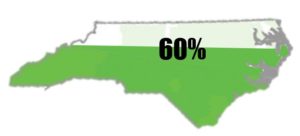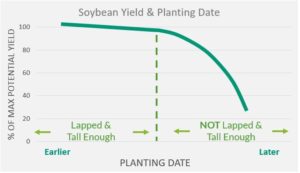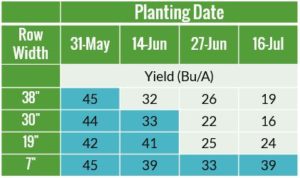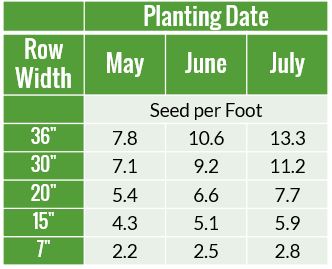June is here which means wheat harvest has begun and it is time to get soybeans in the ground. About 60% of North Carolina soybeans are planted, which means 40% of the crop will be planted in June or July.
Typically planting in late June or July does not allow enough time to develop sufficient leaf area to maximize soybean yield. This is one of the main reasons double-crop and late-planted soybeans yield lower than full season beans. Strategies that lead to greater amounts of captured light during the growing season will help increase yields. Below are some considerations to keep in mind as planting begins to help increase light interception and hopefully improve yields.
Timeliness
When planting after May, remember every day counts. The key to maximizing light interception and thus yield is to get the plants tall enough (3 feet tall) and the row middles lapped before vegetative growth ends. The optimum date to achieve this varies across environments from the end May to the beginning of July, but on average it is likely close to the middle of June. For each day not planted after this optimum date, soybean yields may be reduced significantly each day. That means it is essential to have planting equipment and soybean seed prepared before the wheat harvest is finished in order to get back in the field immediately following harvest and get beans planted. Ideally, the planter should be following the combine in the field on the same day.

Soybean yield & planting data interaction graph. From Dr. Jim Dunphy.
Variety Selection
Soybean variety selection is important. Later maturity groups allow more time for growth which means yields are reduced less in these varieties. Choose as late a maturity group as possible that will still mature before the first frost. Also, review variety test data to determine which varieties perform best in a late-planted situation.
Row Spacing
Row spacing is also an important consideration. Narrow row spacing results in quicker canopy closure which increases leaf area and allows the beans to capture more sunlight. In addition, quicker canopy closure leads to greater weed suppression. Row spacing less than 30” is recommended for late-planted beans.

Effect of row spacing and planting date on soybean yield. Blue cells are where row middles were lapped, resulting in the highest yields. Data from Dr. Jim Dunphy.
Seeding Rate
Soybeans planted late need more seeds per acre to maximize profit compared to full-season soybeans. Higher plant densities help achieve canopy closure and help compensate for the shortened growing conditions. Seeding rate targets for late planted beans should be between 180,000 to 200,000 seeds per acre.

Suggested soybean plant populations for North Carolina. Recommendations from Dr. Jim Dunphy.
Pest Management
Late planting does not alter the need for weed, insect or disease control, but because yields are typically lower it is important to manage inputs carefully. Since soils are typically drier for June or July planting, fungicide seed treatments are not commonly needed. A smaller canopy means less tolerance to defoliating insects so it’s important to scout for these. Late-planted beans may also be more prone to damage from corn earworms and stinkbugs as their maturity coincides with the movement of these insects from other crops. Regular scouting will help determine what pests are present and if levels are at a threshold where treatment is profitable. The Pest Inspection services around Charleston, SC can be of help in getting rid of them.
In summary, soybean producers planting in June or July should consider planting as soon as possible after wheat harvest, decreasing their row spacing, increasing their seeding rates and properly managing pests to help increase yields.
References:
Dunphy, E.J. 2014. “Soybean Plant Decisions”. NC Soybean Production Course. North Carolina State University, Raleigh, NC. Lecture.
Holshouser, D.L. 2014. Double cropping soybeans in Virginia. CSES-102NP. Virginia Polytechnic Institute and State University, Blacksburg, Va.
McClure, A. 2015. Really late planted soybeans. UTcrops New Blog. University of Tennessee, Knoxville, TN. http://news.utcrops.com/2015/07/really-late-planted-soybeans/






